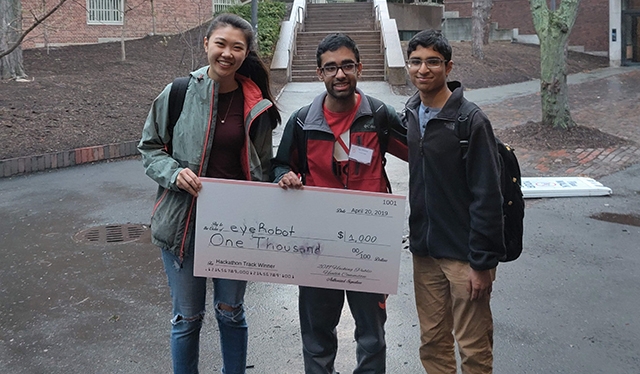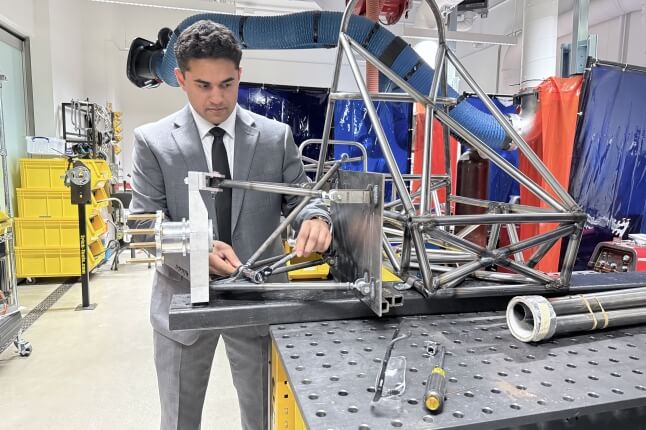News
Ophthalmologists at the Srikiran Institute of Ophthalmology in southern India periodically visit remote communities, providing screenings and treatment to impoverished patients who cannot travel to the city for care. But the equipment necessary to perform one of the most important tests, an endothelial screening, is too bulky and expensive to move out of the hospital.
A solution to their problem is coming from an unexpected source—a new student club at the Harvard John A. Paulson School of Engineering and Applied Sciences. The Global Alliance for Medical Innovation (GAMI) is developing a portable device that can conduct a low-cost endothelial screening using a smartphone.
The new student club jumped on the project shortly after its establishment in the fall of 2018, said founder Sreekar Mantena. He decided to launch GAMI after taking a global health class that showcased how low-cost technologies could solve some of the most pressing health issues in low- and middle-income countries.
“During the recent Ebola epidemic, for instance, clinicians had issues getting access to equipment as simple as an IV and IV pumps,” said Mantena, who just started his sophomore year. “I recognized the critical role technology plays in health care delivery. Innovating and developing low-cost technologies has immense potential to improve the way clinicians in these settings are able to treat their patients.”
So Mantena started talking to friends, and soon found that many students shared his passions for global health and technology. After reaching out to faculty members for advice, he was convinced a student club could make an impact.
GAMI reached out to several clinics, and connected with the director of the Srikiran Institute of Ophthalmology. The students immediately got to work on the endothelial screening project.
“It was a little daunting at first because none of us are ophthalmologists or have any training in this area, but we read through a lot of literature and we’ve been working with professors and physicians in the Department of Global Health and the Department of Ophthalmology on developing the device to make it most clinically successful,” he said. “We are designing the device so you don’t necessarily need a board-certified ophthalmologist to use it. You could have a community health worker go to a rural village, administer these tests, and deliver the results to patients. We are trying to make it as low-cost and as accessible as possible.”
They are prototyping a 3D-printed adapter that enables a smart phone to capture a high-quality image of the corneal endothelium by connecting it to a slit lamp, a microscope used for optical imaging.
The students are also developing an app that enables clinicians to process the captured image, as well as machine-learning algorithms that can take that high-quality smartphone image, segment the endothelial cells, count their density, and characterize their shape—important markers for clinical diagnosis, Mantena explained.
Ensuring the algorithm can run on a smartphone without the need for extra computing power is one of the biggest challenges. Another challenge comes from the need to drive down costs so under-resourced clinics can afford the device.
While the team is still perfecting the hardware and training the neural network, they received a big vote of confidence by winning the Harvard Global Health Hackathon earlier this year. Their goal is to perform a randomized control trial this fall.
The Global Alliance for Medical Innovation team won first place in the Harvard Global Health Hackathon's AI in Healthcare track for their project, dubbed "eyeRobot." Pictured are GAMI team members (from left) Annie Miall, Jay Chandra, and Sreekar Mantena. (Photo provided by Sreekar Mantena)
“We are at the intersection of computer programming, engineering, and medicine. It is extremely exciting to be working in this rapidly developing and evolving area,” said board member Jay Chandra, A.B. ’22. “I really like how GAMI makes a real impact by working on projects that can help increase the access to medicine around the world.”
Empowering students to make a real-world impact is one goal of GAMI, which currently has about 15 members from a variety of concentrations. In addition to its engineering focus, the club has an advocacy arm that has partnered with Boston nonprofits to reduce the price of prescription medications in Massachusetts and around the world.
The club, in collaboration with students from the Harvard Law School and Harvard Kennedy School, and Universities Allied for Essential Medications, is working to champion Massachusetts Bill S.706, An Act to Ensure Prescription Drug Cost Transparency and Affordability.
“Many members of our advocacy team have taken humanities and anthropology classes and understand the underlying socioeconomic disparities faced in developing countries,” Mantena said. “Their perspectives play an important role in shaping our technological development. When deploying a medical device, it is critical to take into consideration these socioeconomic and cultural concerns.”
Moving forward, the advocacy team will work to reform the way medications are licensed in the U.S. to improve access for underserved and uninsured individuals, while the engineering team is gearing up to start multiple projects next year with clinical partners in South America, Africa, and South Asia.
Harvard’s well-connected network of faculty members has helped the nascent club build partnerships with clinicians all over the world, Mantena said. The University’s interdisciplinary culture has been a key asset.
That interdisciplinary focus is also a driving force behind GAMI, whose members are computer scientists, engineers, anthropologists, political scientists, economists, and social scientists—all coming together to improve care for patients around the world.
“We are continually expanding our engineering, software, advocacy, and leadership skills while tackling meaningful problems. I believe student members can leverage the experiences they’ve gained in GAMI to build impactful healthcare solutions in the future,” he said. “A lot of people think it is not possible for students to develop and deploy medical devices, but the goal of this organization is to turn that mindset on its head.”
-------------
GAMI is currently recruiting new members; interested undergraduate and graduate students can join here.
Topics: Student Organizations
Cutting-edge science delivered direct to your inbox.
Join the Harvard SEAS mailing list.
Press Contact
Adam Zewe | 617-496-5878 | azewe@seas.harvard.edu



